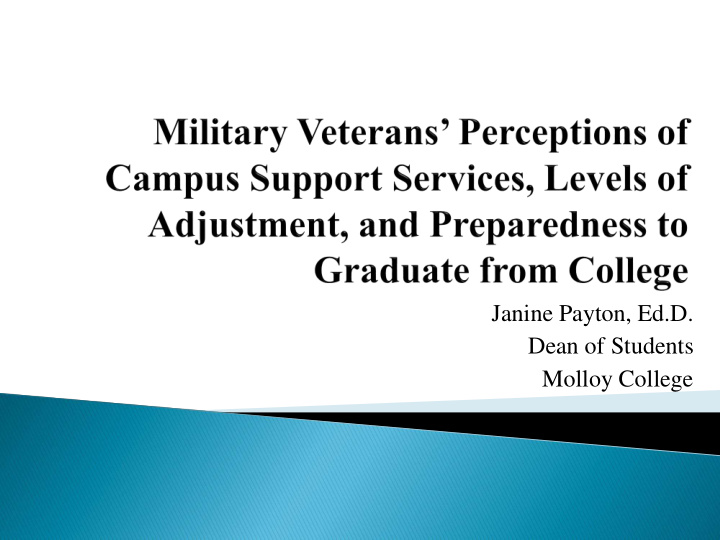



Janine Payton, Ed.D. Dean of Students Molloy College
On August 1, 2009, the most comprehensive veterans’ education benefit program since the original Post-World War II GI Bill went into effect (Cook & Kim, 2009). The Post-9/11 GI Bill offers tuition and fees equivalent to the most expensive rate of tuition at a public college or university in the state, monthly housing allowance, and a book stipend to veterans who served at least 90 days of continuous service after September 10, 2001(Griffin & Gilbert, 2012).
To date, there is little or no information to evaluate whether efforts made by colleges and universities are helpful to the veterans and service members enrolled in higher education, and whether or not military veterans are engaged in academic programs and campus life to their fullest potential (Kim & Cole, 2013).
1. products of intense educational experience 2. diversity 3. resiliency 4. mission focused 5. service-oriented
To examine the relationship of military veterans’ perception of campus support services on the dimensions of academic advisement, counseling services, extracurricular activities, and career services; and social/personal, academic, and institutional adjustment from institutions of higher education in the United States .
Several demands are placed on students as they transition to college, and are comprised of social, personal, academic, and institutional challenges. Therefore, persistence in college requires students to adjust both socially and intellectually to a new environment (Baker & Siryk, 1984).
Academic Advisement Social/Personal Adjustment Counseling Services Preparedness Academic to Graduate Adjustment from College Extracurricular Activities Institutional Adjustment Career Services
While studies in the area of military veterans and their return to civilian life exist, there is a deficit in examining how well they adjust to college/university life, and their perceptions of campus support services related to their preparedness to graduate from college.
This study was limited to colleges and universities in the Unites States who have a Student Veterans Organization (SVO) on their campus. It did not include veterans on college campuses that do not have a SVO, or veterans on campuses that choose not to participate in a SVO.
To measure military veterans’ perceptions of adjustment, military veterans were asked to respond to questions derived from Kaya and Weber’s (2003) adjustment scale. To measure military veterans’ perceptions of campus support services, military veterans were asked to respond to questions derived from appropriate literature.
Gender Percent Age Group Percent Male 71.3 20-29 26.82 Female 28.7 30-39 35.63 40-49 15.33 50 and up 7.66 Missing 14.56
Branch of Military Percent Army 53.6 Marine Corps 14.5 Navy 18.7 Air Force 11.9 Coast Guard 1.3
Type of Institution Percent 2-year public 12.8 2-year private 2.2 4-year public 54.6 4-year private 30.4
Overall, military veterans considered Academic Advisement to be the most valuable campus support service to them in college. Military veterans did not consider Counseling Services to be valuable to them on their campus. Overall, institutional adjustment had the highest mean score. Military veterans perceived institutional adjustment to have the largest influence on their preparedness to graduate from college. Social/personal adjustment had the least influence on the military veterans’ perception of preparedness to graduate from college.
Males/Females There was a significant difference between male veterans (M = 21.07, SD = 8.59) and female veterans (M = 17.60, SD = 8.31) in reporting their perception and use of career services (p =.01), which suggests that male veterans utilized career services significantly more than female veterans. There was a significant difference between male veterans (M = 16.26, SD = 5.06) and female veterans (M = 18.40, SD = 5.38) in reporting their perception and use of extracurricular activities (p = .01), which suggests that female veterans utilized extracurricular activities significantly more than male veterans.
There was a significant difference between veterans attending four-year public institutions (M=20.90, SD=6.24) and those attending four-year private institutions (M=18.58, SD=5.95) on the dimension of social personal adjustment (p=0.02), which suggests that veterans attending four-year public institutions feel more adjusted socially and personally than those attending four-year private institutions.
There was a significant difference between veterans attending college full-time (M=38.16, SD=5.97) and those attending college part-time (M= 33.89, SD=6.47) on the dimension of academic adjustment (p=0.00) which indicates that veterans attending college full-time consider themselves to be more adjusted academically than those attending college part- time.
The results suggest that institutional adjustment had the strongest relationship to a military veterans feeling of preparedness for graduation from college, accounting for approximately 9% of the variance. The strongest relationship existed between academic adjustment and institutional adjustment , accounting for 12.82% of the variance.
Thank you Janine Payton jpayton@molloy.edu
Recommend
More recommend